Analyzing Kurdistan's Path to Statehood in the Middle East
VerifiedAdded on 2020/01/23
|37
|11948
|162
Thesis and Dissertation
AI Summary
This dissertation investigates the complex issue of Kurdistan's potential emergence as an independent state within the volatile context of the Middle East. The research begins with an introduction outlining the background, rationale, aims, objectives, and research questions, emphasizing the significance of the study within the current geopolitical climate. A comprehensive literature review provides historical context, examining the Kurds' historical presence, cultural identity, and the impact of regional powers. The methodology section details the research paradigm, approach, design, data collection, and analysis methods employed, ensuring the validity and reliability of the findings. The analysis chapter presents the findings and insights derived from the research, followed by a conclusion that links back to the objectives and offers recommendations for future studies. The study explores the causes behind the unstable political and social situation, the effects of instability in the region, and Kurdistan's chances of statehood, considering the responses of governments and international bodies. The research also discusses the limitations and future scope of the study, offering a thorough understanding of the challenges and opportunities facing Kurdistan's aspirations for statehood.
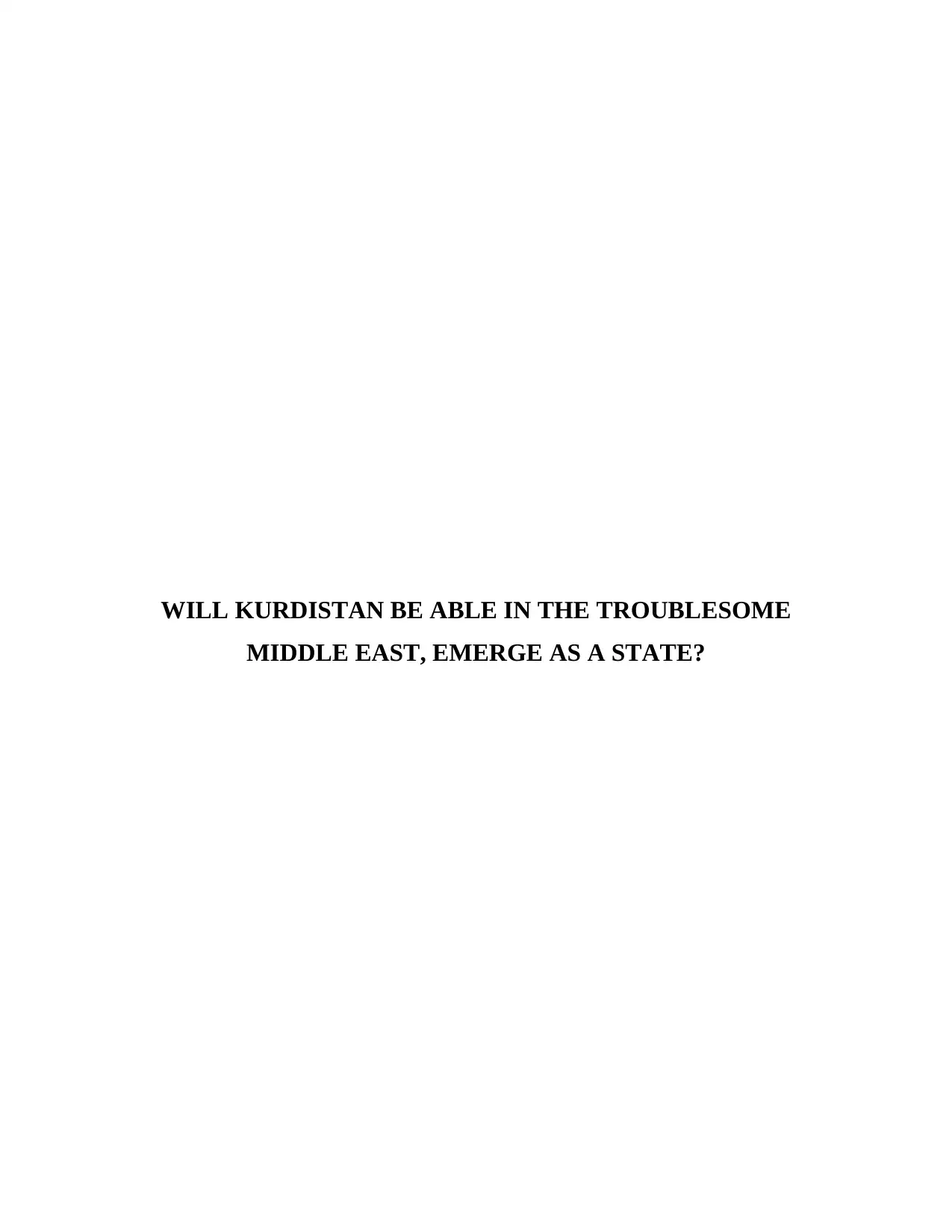
WILL KURDISTAN BE ABLE IN THE TROUBLESOME
MIDDLE EAST, EMERGE AS A STATE?
MIDDLE EAST, EMERGE AS A STATE?
Paraphrase This Document
Need a fresh take? Get an instant paraphrase of this document with our AI Paraphraser
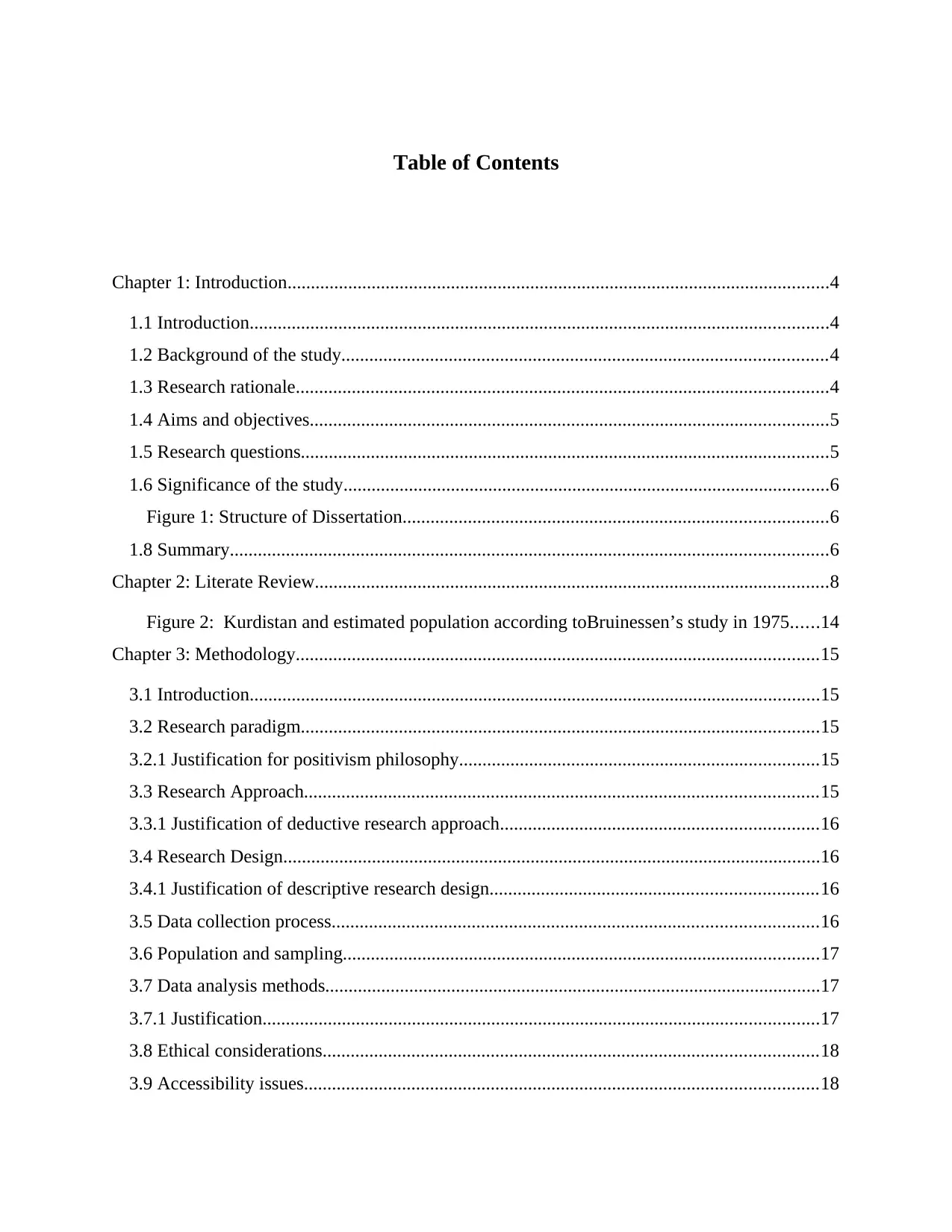
Table of Contents
Chapter 1: Introduction....................................................................................................................4
1.1 Introduction............................................................................................................................4
1.2 Background of the study........................................................................................................4
1.3 Research rationale..................................................................................................................4
1.4 Aims and objectives...............................................................................................................5
1.5 Research questions.................................................................................................................5
1.6 Significance of the study........................................................................................................6
Figure 1: Structure of Dissertation...........................................................................................6
1.8 Summary................................................................................................................................6
Chapter 2: Literate Review..............................................................................................................8
Figure 2: Kurdistan and estimated population according toBruinessen’s study in 1975......14
Chapter 3: Methodology................................................................................................................15
3.1 Introduction..........................................................................................................................15
3.2 Research paradigm...............................................................................................................15
3.2.1 Justification for positivism philosophy.............................................................................15
3.3 Research Approach..............................................................................................................15
3.3.1 Justification of deductive research approach....................................................................16
3.4 Research Design...................................................................................................................16
3.4.1 Justification of descriptive research design......................................................................16
3.5 Data collection process........................................................................................................16
3.6 Population and sampling......................................................................................................17
3.7 Data analysis methods..........................................................................................................17
3.7.1 Justification.......................................................................................................................17
3.8 Ethical considerations..........................................................................................................18
3.9 Accessibility issues..............................................................................................................18
Chapter 1: Introduction....................................................................................................................4
1.1 Introduction............................................................................................................................4
1.2 Background of the study........................................................................................................4
1.3 Research rationale..................................................................................................................4
1.4 Aims and objectives...............................................................................................................5
1.5 Research questions.................................................................................................................5
1.6 Significance of the study........................................................................................................6
Figure 1: Structure of Dissertation...........................................................................................6
1.8 Summary................................................................................................................................6
Chapter 2: Literate Review..............................................................................................................8
Figure 2: Kurdistan and estimated population according toBruinessen’s study in 1975......14
Chapter 3: Methodology................................................................................................................15
3.1 Introduction..........................................................................................................................15
3.2 Research paradigm...............................................................................................................15
3.2.1 Justification for positivism philosophy.............................................................................15
3.3 Research Approach..............................................................................................................15
3.3.1 Justification of deductive research approach....................................................................16
3.4 Research Design...................................................................................................................16
3.4.1 Justification of descriptive research design......................................................................16
3.5 Data collection process........................................................................................................16
3.6 Population and sampling......................................................................................................17
3.7 Data analysis methods..........................................................................................................17
3.7.1 Justification.......................................................................................................................17
3.8 Ethical considerations..........................................................................................................18
3.9 Accessibility issues..............................................................................................................18
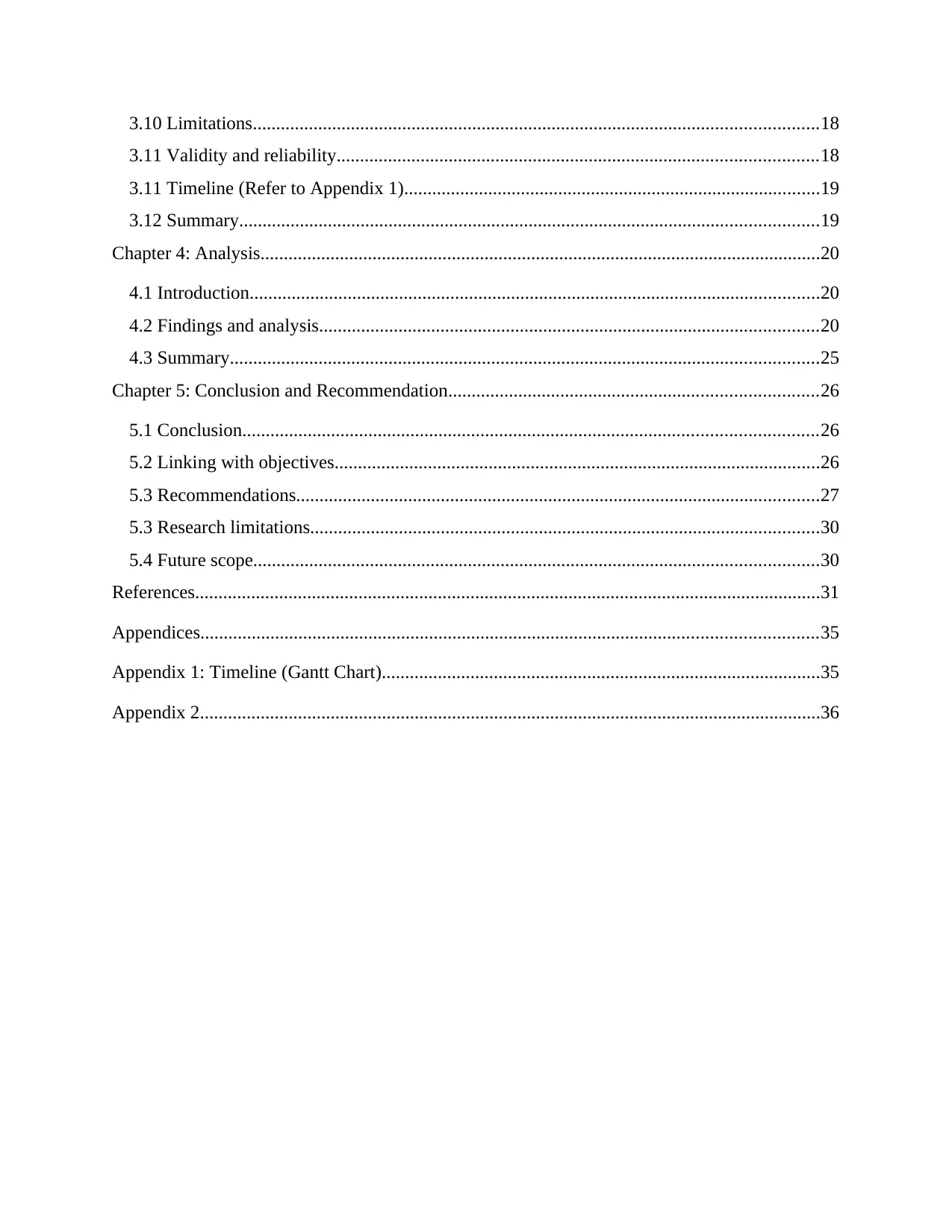
3.10 Limitations.........................................................................................................................18
3.11 Validity and reliability.......................................................................................................18
3.11 Timeline (Refer to Appendix 1).........................................................................................19
3.12 Summary............................................................................................................................19
Chapter 4: Analysis........................................................................................................................20
4.1 Introduction..........................................................................................................................20
4.2 Findings and analysis...........................................................................................................20
4.3 Summary..............................................................................................................................25
Chapter 5: Conclusion and Recommendation...............................................................................26
5.1 Conclusion...........................................................................................................................26
5.2 Linking with objectives........................................................................................................26
5.3 Recommendations................................................................................................................27
5.3 Research limitations.............................................................................................................30
5.4 Future scope.........................................................................................................................30
References......................................................................................................................................31
Appendices....................................................................................................................................35
Appendix 1: Timeline (Gantt Chart)..............................................................................................35
Appendix 2.....................................................................................................................................36
3.11 Validity and reliability.......................................................................................................18
3.11 Timeline (Refer to Appendix 1).........................................................................................19
3.12 Summary............................................................................................................................19
Chapter 4: Analysis........................................................................................................................20
4.1 Introduction..........................................................................................................................20
4.2 Findings and analysis...........................................................................................................20
4.3 Summary..............................................................................................................................25
Chapter 5: Conclusion and Recommendation...............................................................................26
5.1 Conclusion...........................................................................................................................26
5.2 Linking with objectives........................................................................................................26
5.3 Recommendations................................................................................................................27
5.3 Research limitations.............................................................................................................30
5.4 Future scope.........................................................................................................................30
References......................................................................................................................................31
Appendices....................................................................................................................................35
Appendix 1: Timeline (Gantt Chart)..............................................................................................35
Appendix 2.....................................................................................................................................36
⊘ This is a preview!⊘
Do you want full access?
Subscribe today to unlock all pages.

Trusted by 1+ million students worldwide
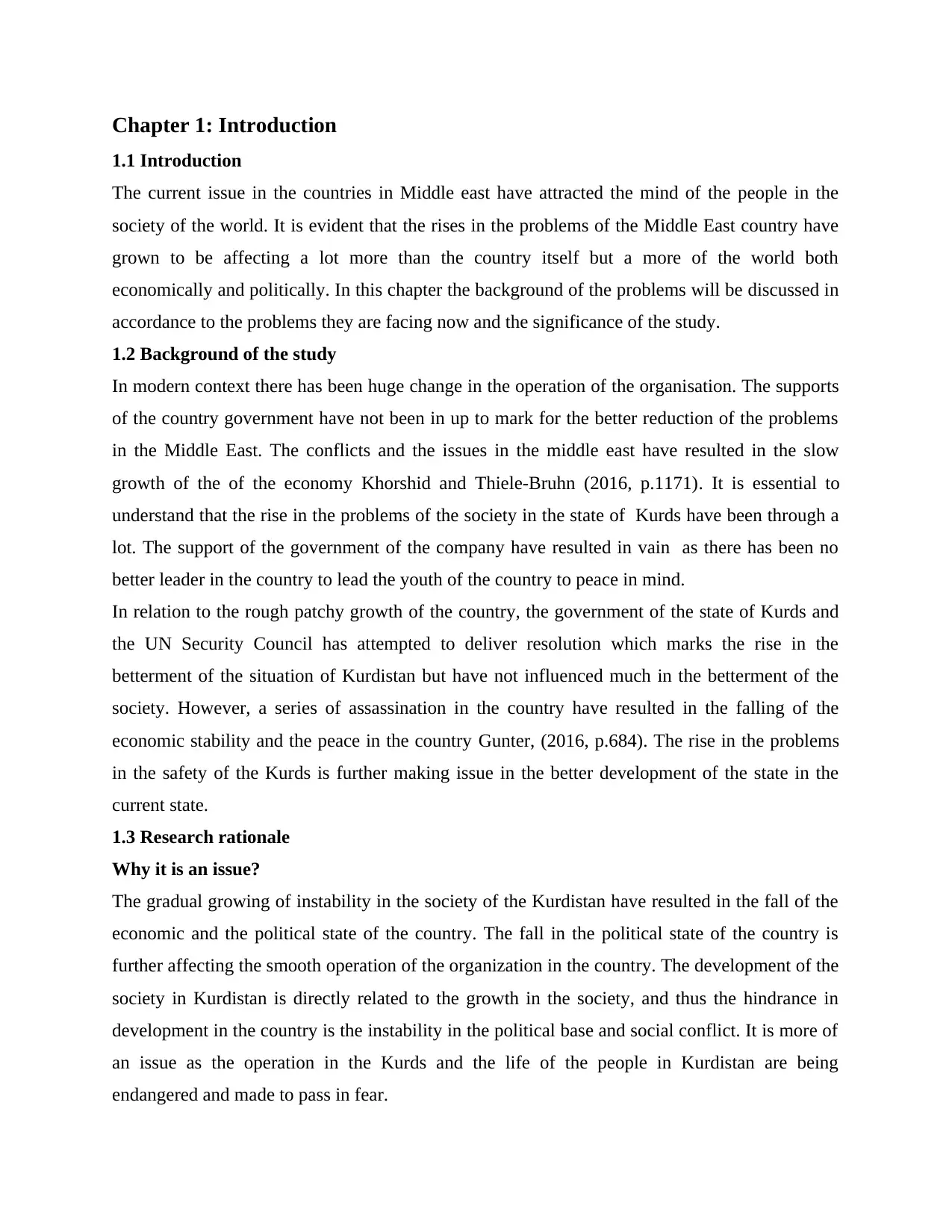
Chapter 1: Introduction
1.1 Introduction
The current issue in the countries in Middle east have attracted the mind of the people in the
society of the world. It is evident that the rises in the problems of the Middle East country have
grown to be affecting a lot more than the country itself but a more of the world both
economically and politically. In this chapter the background of the problems will be discussed in
accordance to the problems they are facing now and the significance of the study.
1.2 Background of the study
In modern context there has been huge change in the operation of the organisation. The supports
of the country government have not been in up to mark for the better reduction of the problems
in the Middle East. The conflicts and the issues in the middle east have resulted in the slow
growth of the of the economy Khorshid and Thiele-Bruhn (2016, p.1171). It is essential to
understand that the rise in the problems of the society in the state of Kurds have been through a
lot. The support of the government of the company have resulted in vain as there has been no
better leader in the country to lead the youth of the country to peace in mind.
In relation to the rough patchy growth of the country, the government of the state of Kurds and
the UN Security Council has attempted to deliver resolution which marks the rise in the
betterment of the situation of Kurdistan but have not influenced much in the betterment of the
society. However, a series of assassination in the country have resulted in the falling of the
economic stability and the peace in the country Gunter, (2016, p.684). The rise in the problems
in the safety of the Kurds is further making issue in the better development of the state in the
current state.
1.3 Research rationale
Why it is an issue?
The gradual growing of instability in the society of the Kurdistan have resulted in the fall of the
economic and the political state of the country. The fall in the political state of the country is
further affecting the smooth operation of the organization in the country. The development of the
society in Kurdistan is directly related to the growth in the society, and thus the hindrance in
development in the country is the instability in the political base and social conflict. It is more of
an issue as the operation in the Kurds and the life of the people in Kurdistan are being
endangered and made to pass in fear.
1.1 Introduction
The current issue in the countries in Middle east have attracted the mind of the people in the
society of the world. It is evident that the rises in the problems of the Middle East country have
grown to be affecting a lot more than the country itself but a more of the world both
economically and politically. In this chapter the background of the problems will be discussed in
accordance to the problems they are facing now and the significance of the study.
1.2 Background of the study
In modern context there has been huge change in the operation of the organisation. The supports
of the country government have not been in up to mark for the better reduction of the problems
in the Middle East. The conflicts and the issues in the middle east have resulted in the slow
growth of the of the economy Khorshid and Thiele-Bruhn (2016, p.1171). It is essential to
understand that the rise in the problems of the society in the state of Kurds have been through a
lot. The support of the government of the company have resulted in vain as there has been no
better leader in the country to lead the youth of the country to peace in mind.
In relation to the rough patchy growth of the country, the government of the state of Kurds and
the UN Security Council has attempted to deliver resolution which marks the rise in the
betterment of the situation of Kurdistan but have not influenced much in the betterment of the
society. However, a series of assassination in the country have resulted in the falling of the
economic stability and the peace in the country Gunter, (2016, p.684). The rise in the problems
in the safety of the Kurds is further making issue in the better development of the state in the
current state.
1.3 Research rationale
Why it is an issue?
The gradual growing of instability in the society of the Kurdistan have resulted in the fall of the
economic and the political state of the country. The fall in the political state of the country is
further affecting the smooth operation of the organization in the country. The development of the
society in Kurdistan is directly related to the growth in the society, and thus the hindrance in
development in the country is the instability in the political base and social conflict. It is more of
an issue as the operation in the Kurds and the life of the people in Kurdistan are being
endangered and made to pass in fear.
Paraphrase This Document
Need a fresh take? Get an instant paraphrase of this document with our AI Paraphraser
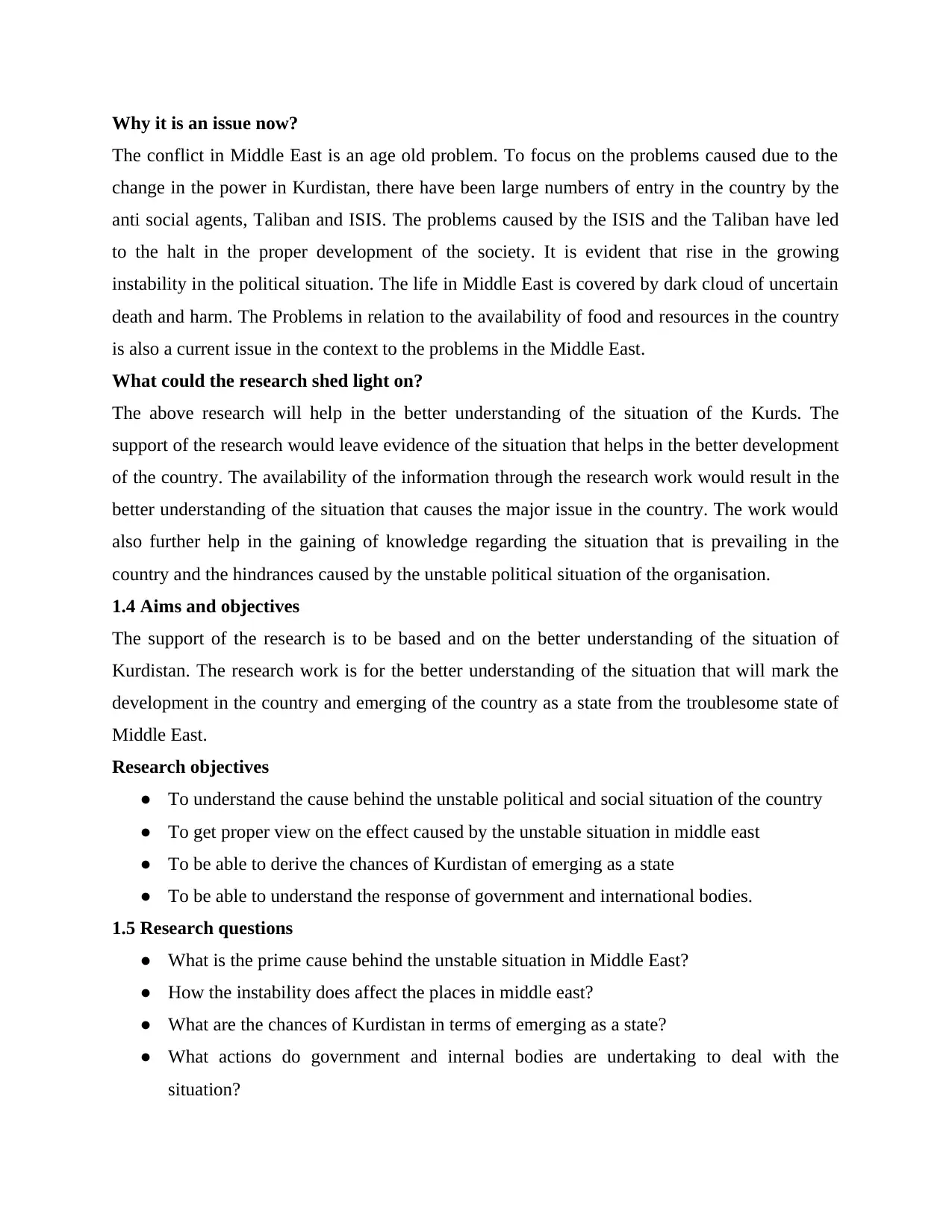
Why it is an issue now?
The conflict in Middle East is an age old problem. To focus on the problems caused due to the
change in the power in Kurdistan, there have been large numbers of entry in the country by the
anti social agents, Taliban and ISIS. The problems caused by the ISIS and the Taliban have led
to the halt in the proper development of the society. It is evident that rise in the growing
instability in the political situation. The life in Middle East is covered by dark cloud of uncertain
death and harm. The Problems in relation to the availability of food and resources in the country
is also a current issue in the context to the problems in the Middle East.
What could the research shed light on?
The above research will help in the better understanding of the situation of the Kurds. The
support of the research would leave evidence of the situation that helps in the better development
of the country. The availability of the information through the research work would result in the
better understanding of the situation that causes the major issue in the country. The work would
also further help in the gaining of knowledge regarding the situation that is prevailing in the
country and the hindrances caused by the unstable political situation of the organisation.
1.4 Aims and objectives
The support of the research is to be based and on the better understanding of the situation of
Kurdistan. The research work is for the better understanding of the situation that will mark the
development in the country and emerging of the country as a state from the troublesome state of
Middle East.
Research objectives
● To understand the cause behind the unstable political and social situation of the country
● To get proper view on the effect caused by the unstable situation in middle east
● To be able to derive the chances of Kurdistan of emerging as a state
● To be able to understand the response of government and international bodies.
1.5 Research questions
● What is the prime cause behind the unstable situation in Middle East?
● How the instability does affect the places in middle east?
● What are the chances of Kurdistan in terms of emerging as a state?
● What actions do government and internal bodies are undertaking to deal with the
situation?
The conflict in Middle East is an age old problem. To focus on the problems caused due to the
change in the power in Kurdistan, there have been large numbers of entry in the country by the
anti social agents, Taliban and ISIS. The problems caused by the ISIS and the Taliban have led
to the halt in the proper development of the society. It is evident that rise in the growing
instability in the political situation. The life in Middle East is covered by dark cloud of uncertain
death and harm. The Problems in relation to the availability of food and resources in the country
is also a current issue in the context to the problems in the Middle East.
What could the research shed light on?
The above research will help in the better understanding of the situation of the Kurds. The
support of the research would leave evidence of the situation that helps in the better development
of the country. The availability of the information through the research work would result in the
better understanding of the situation that causes the major issue in the country. The work would
also further help in the gaining of knowledge regarding the situation that is prevailing in the
country and the hindrances caused by the unstable political situation of the organisation.
1.4 Aims and objectives
The support of the research is to be based and on the better understanding of the situation of
Kurdistan. The research work is for the better understanding of the situation that will mark the
development in the country and emerging of the country as a state from the troublesome state of
Middle East.
Research objectives
● To understand the cause behind the unstable political and social situation of the country
● To get proper view on the effect caused by the unstable situation in middle east
● To be able to derive the chances of Kurdistan of emerging as a state
● To be able to understand the response of government and international bodies.
1.5 Research questions
● What is the prime cause behind the unstable situation in Middle East?
● How the instability does affect the places in middle east?
● What are the chances of Kurdistan in terms of emerging as a state?
● What actions do government and internal bodies are undertaking to deal with the
situation?
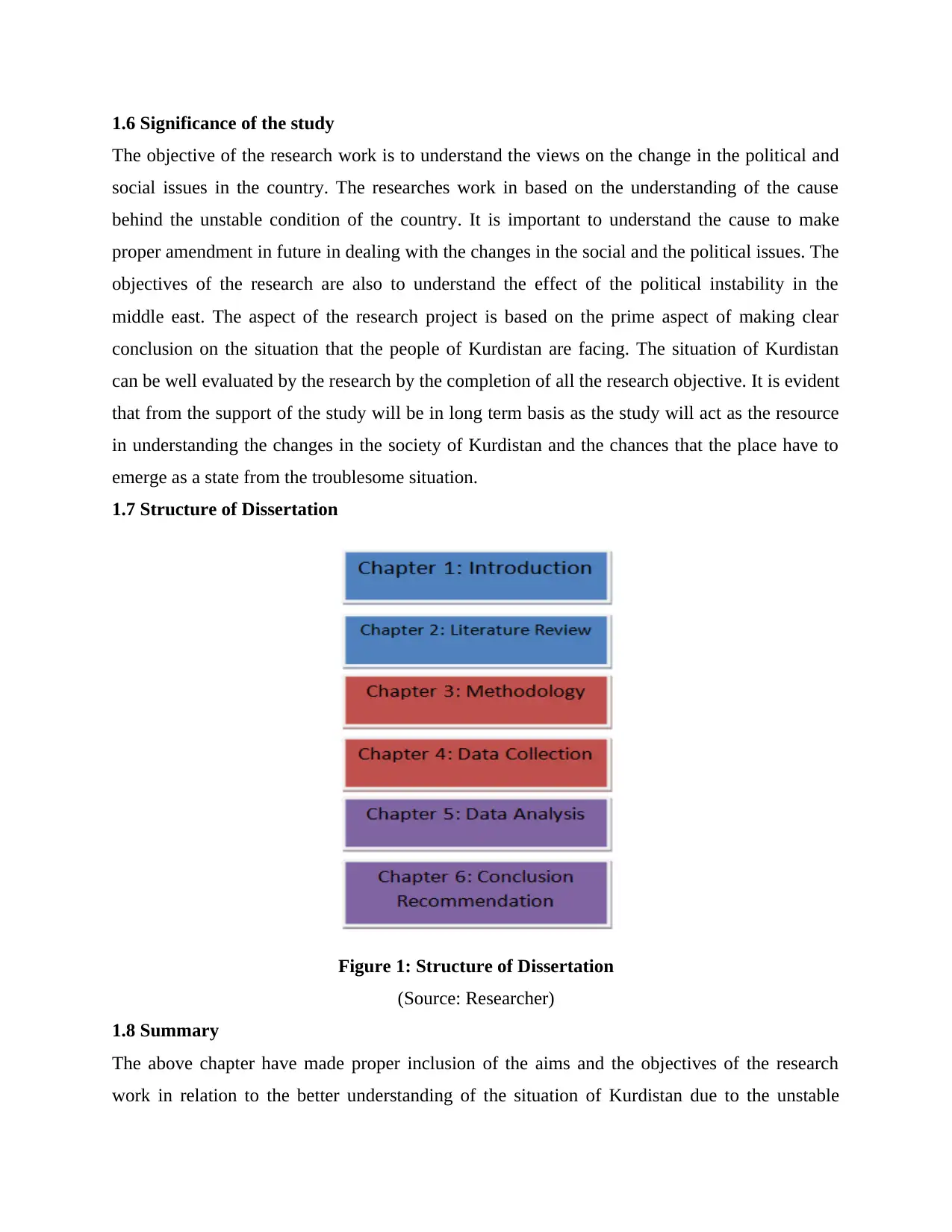
1.6 Significance of the study
The objective of the research work is to understand the views on the change in the political and
social issues in the country. The researches work in based on the understanding of the cause
behind the unstable condition of the country. It is important to understand the cause to make
proper amendment in future in dealing with the changes in the social and the political issues. The
objectives of the research are also to understand the effect of the political instability in the
middle east. The aspect of the research project is based on the prime aspect of making clear
conclusion on the situation that the people of Kurdistan are facing. The situation of Kurdistan
can be well evaluated by the research by the completion of all the research objective. It is evident
that from the support of the study will be in long term basis as the study will act as the resource
in understanding the changes in the society of Kurdistan and the chances that the place have to
emerge as a state from the troublesome situation.
1.7 Structure of Dissertation
Figure 1: Structure of Dissertation
(Source: Researcher)
1.8 Summary
The above chapter have made proper inclusion of the aims and the objectives of the research
work in relation to the better understanding of the situation of Kurdistan due to the unstable
The objective of the research work is to understand the views on the change in the political and
social issues in the country. The researches work in based on the understanding of the cause
behind the unstable condition of the country. It is important to understand the cause to make
proper amendment in future in dealing with the changes in the social and the political issues. The
objectives of the research are also to understand the effect of the political instability in the
middle east. The aspect of the research project is based on the prime aspect of making clear
conclusion on the situation that the people of Kurdistan are facing. The situation of Kurdistan
can be well evaluated by the research by the completion of all the research objective. It is evident
that from the support of the study will be in long term basis as the study will act as the resource
in understanding the changes in the society of Kurdistan and the chances that the place have to
emerge as a state from the troublesome situation.
1.7 Structure of Dissertation
Figure 1: Structure of Dissertation
(Source: Researcher)
1.8 Summary
The above chapter have made proper inclusion of the aims and the objectives of the research
work in relation to the better understanding of the situation of Kurdistan due to the unstable
⊘ This is a preview!⊘
Do you want full access?
Subscribe today to unlock all pages.

Trusted by 1+ million students worldwide
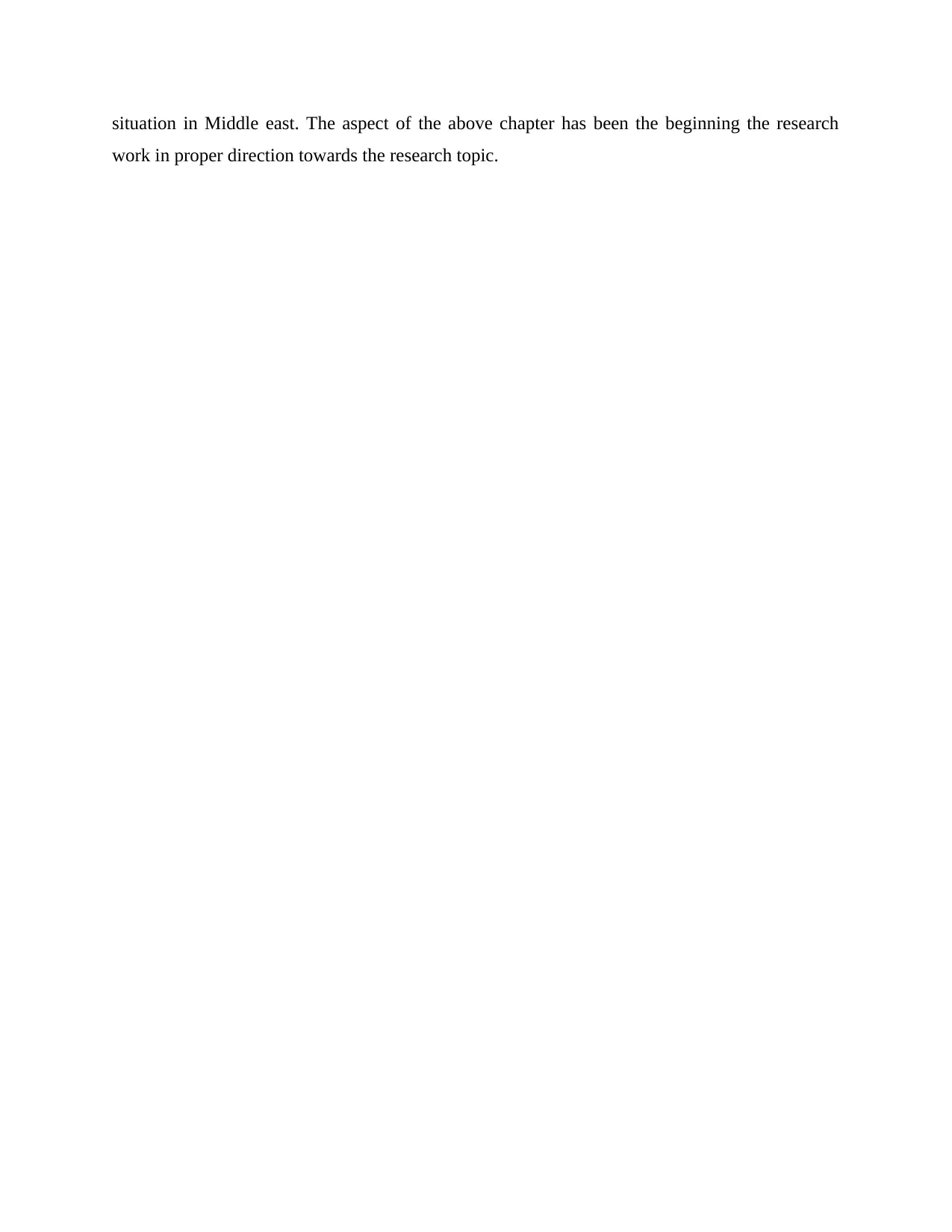
situation in Middle east. The aspect of the above chapter has been the beginning the research
work in proper direction towards the research topic.
work in proper direction towards the research topic.
Paraphrase This Document
Need a fresh take? Get an instant paraphrase of this document with our AI Paraphraser
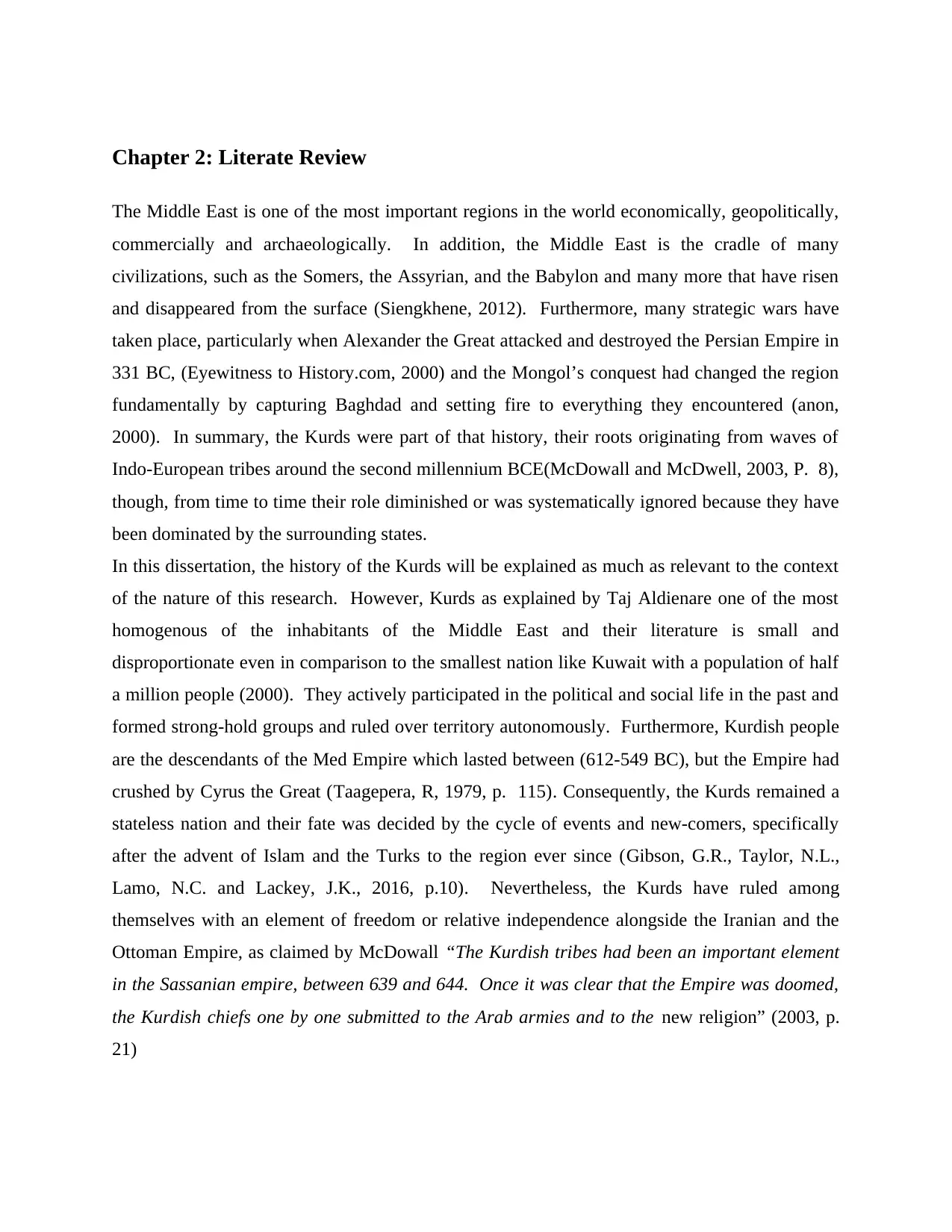
Chapter 2: Literate Review
The Middle East is one of the most important regions in the world economically, geopolitically,
commercially and archaeologically. In addition, the Middle East is the cradle of many
civilizations, such as the Somers, the Assyrian, and the Babylon and many more that have risen
and disappeared from the surface (Siengkhene, 2012). Furthermore, many strategic wars have
taken place, particularly when Alexander the Great attacked and destroyed the Persian Empire in
331 BC, (Eyewitness to History.com, 2000) and the Mongol’s conquest had changed the region
fundamentally by capturing Baghdad and setting fire to everything they encountered (anon,
2000). In summary, the Kurds were part of that history, their roots originating from waves of
Indo-European tribes around the second millennium BCE(McDowall and McDwell, 2003, P. 8),
though, from time to time their role diminished or was systematically ignored because they have
been dominated by the surrounding states.
In this dissertation, the history of the Kurds will be explained as much as relevant to the context
of the nature of this research. However, Kurds as explained by Taj Aldienare one of the most
homogenous of the inhabitants of the Middle East and their literature is small and
disproportionate even in comparison to the smallest nation like Kuwait with a population of half
a million people (2000). They actively participated in the political and social life in the past and
formed strong-hold groups and ruled over territory autonomously. Furthermore, Kurdish people
are the descendants of the Med Empire which lasted between (612-549 BC), but the Empire had
crushed by Cyrus the Great (Taagepera, R, 1979, p. 115). Consequently, the Kurds remained a
stateless nation and their fate was decided by the cycle of events and new-comers, specifically
after the advent of Islam and the Turks to the region ever since (Gibson, G.R., Taylor, N.L.,
Lamo, N.C. and Lackey, J.K., 2016, p.10). Nevertheless, the Kurds have ruled among
themselves with an element of freedom or relative independence alongside the Iranian and the
Ottoman Empire, as claimed by McDowall “The Kurdish tribes had been an important element
in the Sassanian empire, between 639 and 644. Once it was clear that the Empire was doomed,
the Kurdish chiefs one by one submitted to the Arab armies and to the new religion” (2003, p.
21)
The Middle East is one of the most important regions in the world economically, geopolitically,
commercially and archaeologically. In addition, the Middle East is the cradle of many
civilizations, such as the Somers, the Assyrian, and the Babylon and many more that have risen
and disappeared from the surface (Siengkhene, 2012). Furthermore, many strategic wars have
taken place, particularly when Alexander the Great attacked and destroyed the Persian Empire in
331 BC, (Eyewitness to History.com, 2000) and the Mongol’s conquest had changed the region
fundamentally by capturing Baghdad and setting fire to everything they encountered (anon,
2000). In summary, the Kurds were part of that history, their roots originating from waves of
Indo-European tribes around the second millennium BCE(McDowall and McDwell, 2003, P. 8),
though, from time to time their role diminished or was systematically ignored because they have
been dominated by the surrounding states.
In this dissertation, the history of the Kurds will be explained as much as relevant to the context
of the nature of this research. However, Kurds as explained by Taj Aldienare one of the most
homogenous of the inhabitants of the Middle East and their literature is small and
disproportionate even in comparison to the smallest nation like Kuwait with a population of half
a million people (2000). They actively participated in the political and social life in the past and
formed strong-hold groups and ruled over territory autonomously. Furthermore, Kurdish people
are the descendants of the Med Empire which lasted between (612-549 BC), but the Empire had
crushed by Cyrus the Great (Taagepera, R, 1979, p. 115). Consequently, the Kurds remained a
stateless nation and their fate was decided by the cycle of events and new-comers, specifically
after the advent of Islam and the Turks to the region ever since (Gibson, G.R., Taylor, N.L.,
Lamo, N.C. and Lackey, J.K., 2016, p.10). Nevertheless, the Kurds have ruled among
themselves with an element of freedom or relative independence alongside the Iranian and the
Ottoman Empire, as claimed by McDowall “The Kurdish tribes had been an important element
in the Sassanian empire, between 639 and 644. Once it was clear that the Empire was doomed,
the Kurdish chiefs one by one submitted to the Arab armies and to the new religion” (2003, p.
21)
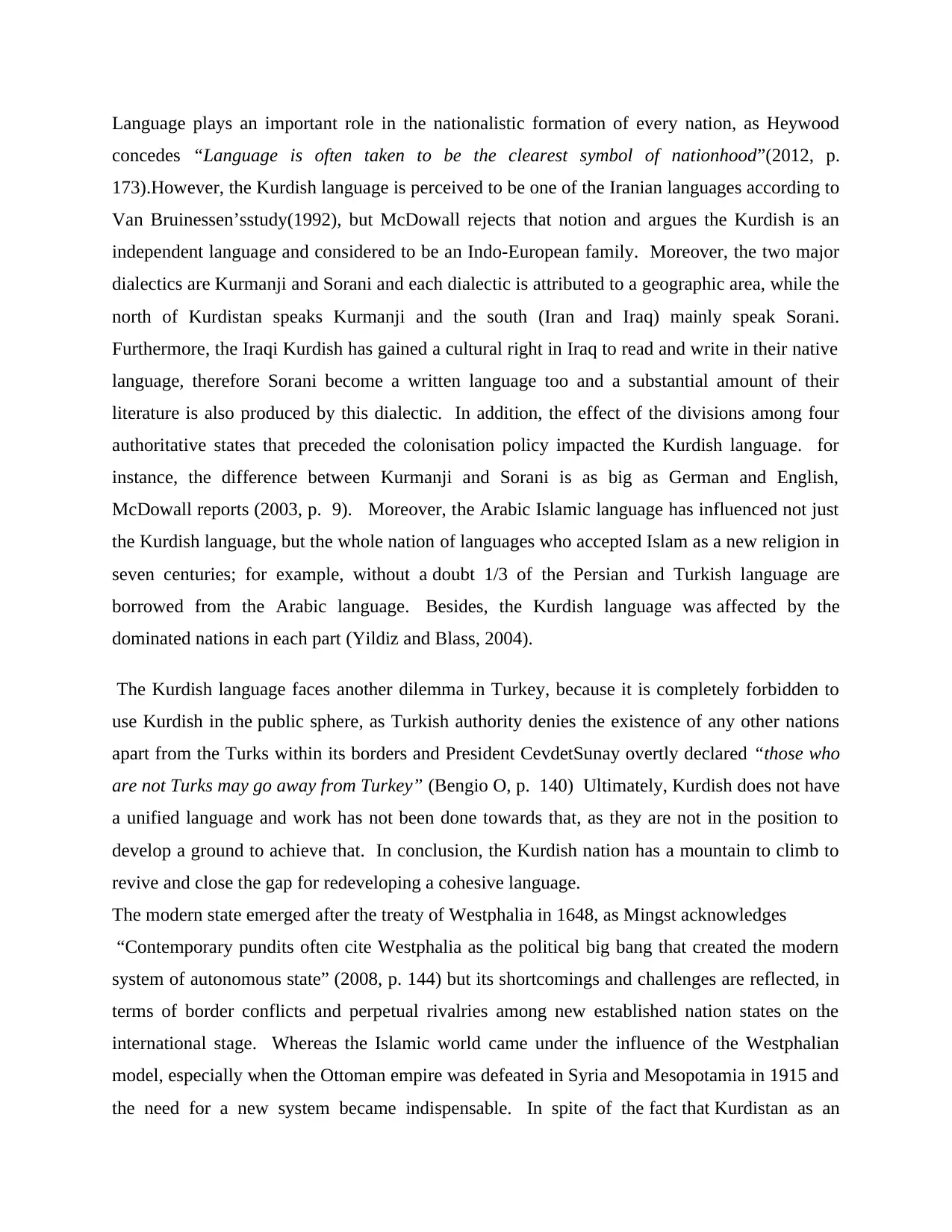
Language plays an important role in the nationalistic formation of every nation, as Heywood
concedes “Language is often taken to be the clearest symbol of nationhood”(2012, p.
173).However, the Kurdish language is perceived to be one of the Iranian languages according to
Van Bruinessen’sstudy(1992), but McDowall rejects that notion and argues the Kurdish is an
independent language and considered to be an Indo-European family. Moreover, the two major
dialectics are Kurmanji and Sorani and each dialectic is attributed to a geographic area, while the
north of Kurdistan speaks Kurmanji and the south (Iran and Iraq) mainly speak Sorani.
Furthermore, the Iraqi Kurdish has gained a cultural right in Iraq to read and write in their native
language, therefore Sorani become a written language too and a substantial amount of their
literature is also produced by this dialectic. In addition, the effect of the divisions among four
authoritative states that preceded the colonisation policy impacted the Kurdish language. for
instance, the difference between Kurmanji and Sorani is as big as German and English,
McDowall reports (2003, p. 9). Moreover, the Arabic Islamic language has influenced not just
the Kurdish language, but the whole nation of languages who accepted Islam as a new religion in
seven centuries; for example, without a doubt 1/3 of the Persian and Turkish language are
borrowed from the Arabic language. Besides, the Kurdish language was affected by the
dominated nations in each part (Yildiz and Blass, 2004).
The Kurdish language faces another dilemma in Turkey, because it is completely forbidden to
use Kurdish in the public sphere, as Turkish authority denies the existence of any other nations
apart from the Turks within its borders and President CevdetSunay overtly declared “those who
are not Turks may go away from Turkey” (Bengio O, p. 140) Ultimately, Kurdish does not have
a unified language and work has not been done towards that, as they are not in the position to
develop a ground to achieve that. In conclusion, the Kurdish nation has a mountain to climb to
revive and close the gap for redeveloping a cohesive language.
The modern state emerged after the treaty of Westphalia in 1648, as Mingst acknowledges
“Contemporary pundits often cite Westphalia as the political big bang that created the modern
system of autonomous state” (2008, p. 144) but its shortcomings and challenges are reflected, in
terms of border conflicts and perpetual rivalries among new established nation states on the
international stage. Whereas the Islamic world came under the influence of the Westphalian
model, especially when the Ottoman empire was defeated in Syria and Mesopotamia in 1915 and
the need for a new system became indispensable. In spite of the fact that Kurdistan as an
concedes “Language is often taken to be the clearest symbol of nationhood”(2012, p.
173).However, the Kurdish language is perceived to be one of the Iranian languages according to
Van Bruinessen’sstudy(1992), but McDowall rejects that notion and argues the Kurdish is an
independent language and considered to be an Indo-European family. Moreover, the two major
dialectics are Kurmanji and Sorani and each dialectic is attributed to a geographic area, while the
north of Kurdistan speaks Kurmanji and the south (Iran and Iraq) mainly speak Sorani.
Furthermore, the Iraqi Kurdish has gained a cultural right in Iraq to read and write in their native
language, therefore Sorani become a written language too and a substantial amount of their
literature is also produced by this dialectic. In addition, the effect of the divisions among four
authoritative states that preceded the colonisation policy impacted the Kurdish language. for
instance, the difference between Kurmanji and Sorani is as big as German and English,
McDowall reports (2003, p. 9). Moreover, the Arabic Islamic language has influenced not just
the Kurdish language, but the whole nation of languages who accepted Islam as a new religion in
seven centuries; for example, without a doubt 1/3 of the Persian and Turkish language are
borrowed from the Arabic language. Besides, the Kurdish language was affected by the
dominated nations in each part (Yildiz and Blass, 2004).
The Kurdish language faces another dilemma in Turkey, because it is completely forbidden to
use Kurdish in the public sphere, as Turkish authority denies the existence of any other nations
apart from the Turks within its borders and President CevdetSunay overtly declared “those who
are not Turks may go away from Turkey” (Bengio O, p. 140) Ultimately, Kurdish does not have
a unified language and work has not been done towards that, as they are not in the position to
develop a ground to achieve that. In conclusion, the Kurdish nation has a mountain to climb to
revive and close the gap for redeveloping a cohesive language.
The modern state emerged after the treaty of Westphalia in 1648, as Mingst acknowledges
“Contemporary pundits often cite Westphalia as the political big bang that created the modern
system of autonomous state” (2008, p. 144) but its shortcomings and challenges are reflected, in
terms of border conflicts and perpetual rivalries among new established nation states on the
international stage. Whereas the Islamic world came under the influence of the Westphalian
model, especially when the Ottoman empire was defeated in Syria and Mesopotamia in 1915 and
the need for a new system became indispensable. In spite of the fact that Kurdistan as an
⊘ This is a preview!⊘
Do you want full access?
Subscribe today to unlock all pages.

Trusted by 1+ million students worldwide
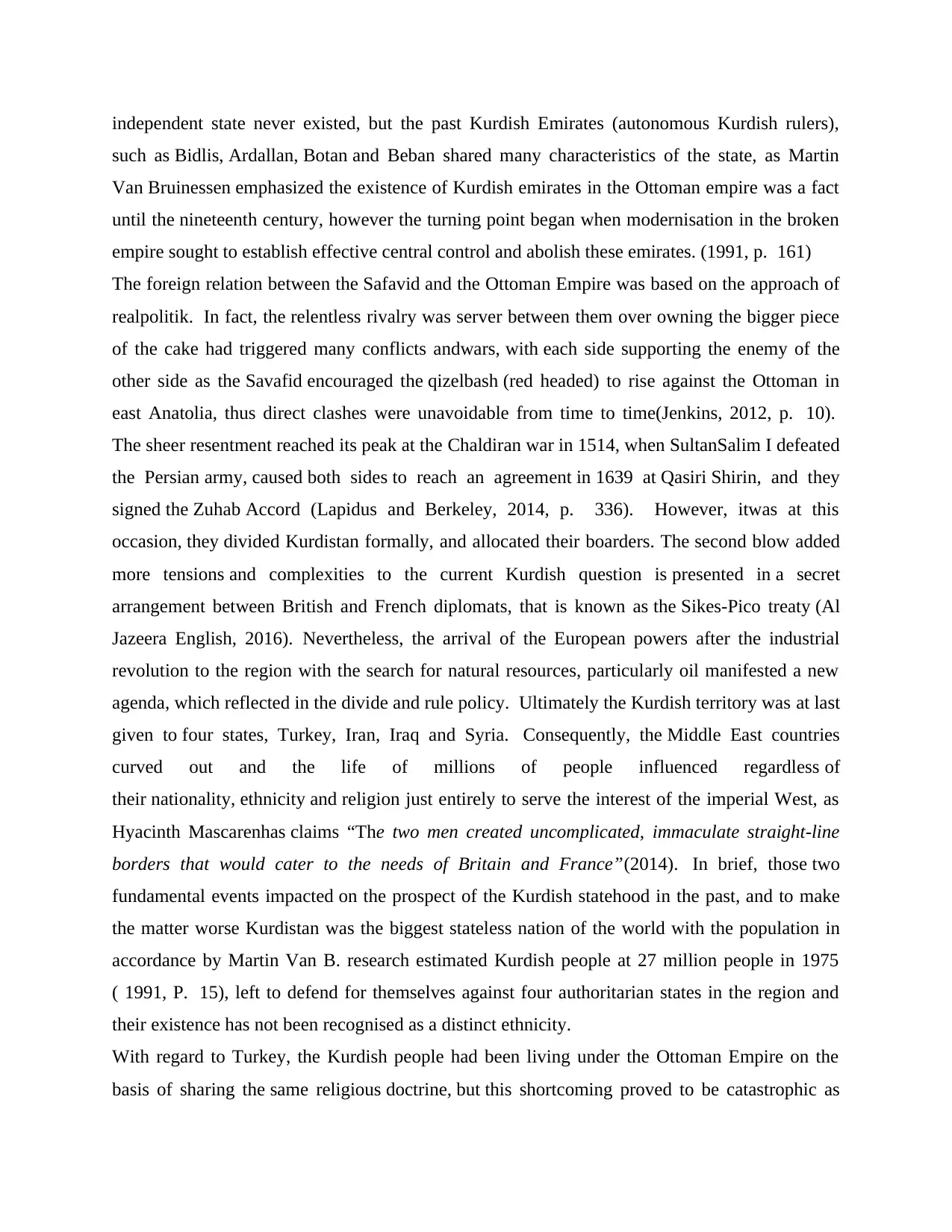
independent state never existed, but the past Kurdish Emirates (autonomous Kurdish rulers),
such as Bidlis, Ardallan, Botan and Beban shared many characteristics of the state, as Martin
Van Bruinessen emphasized the existence of Kurdish emirates in the Ottoman empire was a fact
until the nineteenth century, however the turning point began when modernisation in the broken
empire sought to establish effective central control and abolish these emirates. (1991, p. 161)
The foreign relation between the Safavid and the Ottoman Empire was based on the approach of
realpolitik. In fact, the relentless rivalry was server between them over owning the bigger piece
of the cake had triggered many conflicts andwars, with each side supporting the enemy of the
other side as the Savafid encouraged the qizelbash (red headed) to rise against the Ottoman in
east Anatolia, thus direct clashes were unavoidable from time to time(Jenkins, 2012, p. 10).
The sheer resentment reached its peak at the Chaldiran war in 1514, when SultanSalim I defeated
the Persian army, caused both sides to reach an agreement in 1639 at Qasiri Shirin, and they
signed the Zuhab Accord (Lapidus and Berkeley, 2014, p. 336). However, itwas at this
occasion, they divided Kurdistan formally, and allocated their boarders. The second blow added
more tensions and complexities to the current Kurdish question is presented in a secret
arrangement between British and French diplomats, that is known as the Sikes-Pico treaty (Al
Jazeera English, 2016). Nevertheless, the arrival of the European powers after the industrial
revolution to the region with the search for natural resources, particularly oil manifested a new
agenda, which reflected in the divide and rule policy. Ultimately the Kurdish territory was at last
given to four states, Turkey, Iran, Iraq and Syria. Consequently, the Middle East countries
curved out and the life of millions of people influenced regardless of
their nationality, ethnicity and religion just entirely to serve the interest of the imperial West, as
Hyacinth Mascarenhas claims “The two men created uncomplicated, immaculate straight-line
borders that would cater to the needs of Britain and France”(2014). In brief, those two
fundamental events impacted on the prospect of the Kurdish statehood in the past, and to make
the matter worse Kurdistan was the biggest stateless nation of the world with the population in
accordance by Martin Van B. research estimated Kurdish people at 27 million people in 1975
( 1991, P. 15), left to defend for themselves against four authoritarian states in the region and
their existence has not been recognised as a distinct ethnicity.
With regard to Turkey, the Kurdish people had been living under the Ottoman Empire on the
basis of sharing the same religious doctrine, but this shortcoming proved to be catastrophic as
such as Bidlis, Ardallan, Botan and Beban shared many characteristics of the state, as Martin
Van Bruinessen emphasized the existence of Kurdish emirates in the Ottoman empire was a fact
until the nineteenth century, however the turning point began when modernisation in the broken
empire sought to establish effective central control and abolish these emirates. (1991, p. 161)
The foreign relation between the Safavid and the Ottoman Empire was based on the approach of
realpolitik. In fact, the relentless rivalry was server between them over owning the bigger piece
of the cake had triggered many conflicts andwars, with each side supporting the enemy of the
other side as the Savafid encouraged the qizelbash (red headed) to rise against the Ottoman in
east Anatolia, thus direct clashes were unavoidable from time to time(Jenkins, 2012, p. 10).
The sheer resentment reached its peak at the Chaldiran war in 1514, when SultanSalim I defeated
the Persian army, caused both sides to reach an agreement in 1639 at Qasiri Shirin, and they
signed the Zuhab Accord (Lapidus and Berkeley, 2014, p. 336). However, itwas at this
occasion, they divided Kurdistan formally, and allocated their boarders. The second blow added
more tensions and complexities to the current Kurdish question is presented in a secret
arrangement between British and French diplomats, that is known as the Sikes-Pico treaty (Al
Jazeera English, 2016). Nevertheless, the arrival of the European powers after the industrial
revolution to the region with the search for natural resources, particularly oil manifested a new
agenda, which reflected in the divide and rule policy. Ultimately the Kurdish territory was at last
given to four states, Turkey, Iran, Iraq and Syria. Consequently, the Middle East countries
curved out and the life of millions of people influenced regardless of
their nationality, ethnicity and religion just entirely to serve the interest of the imperial West, as
Hyacinth Mascarenhas claims “The two men created uncomplicated, immaculate straight-line
borders that would cater to the needs of Britain and France”(2014). In brief, those two
fundamental events impacted on the prospect of the Kurdish statehood in the past, and to make
the matter worse Kurdistan was the biggest stateless nation of the world with the population in
accordance by Martin Van B. research estimated Kurdish people at 27 million people in 1975
( 1991, P. 15), left to defend for themselves against four authoritarian states in the region and
their existence has not been recognised as a distinct ethnicity.
With regard to Turkey, the Kurdish people had been living under the Ottoman Empire on the
basis of sharing the same religious doctrine, but this shortcoming proved to be catastrophic as
Paraphrase This Document
Need a fresh take? Get an instant paraphrase of this document with our AI Paraphraser
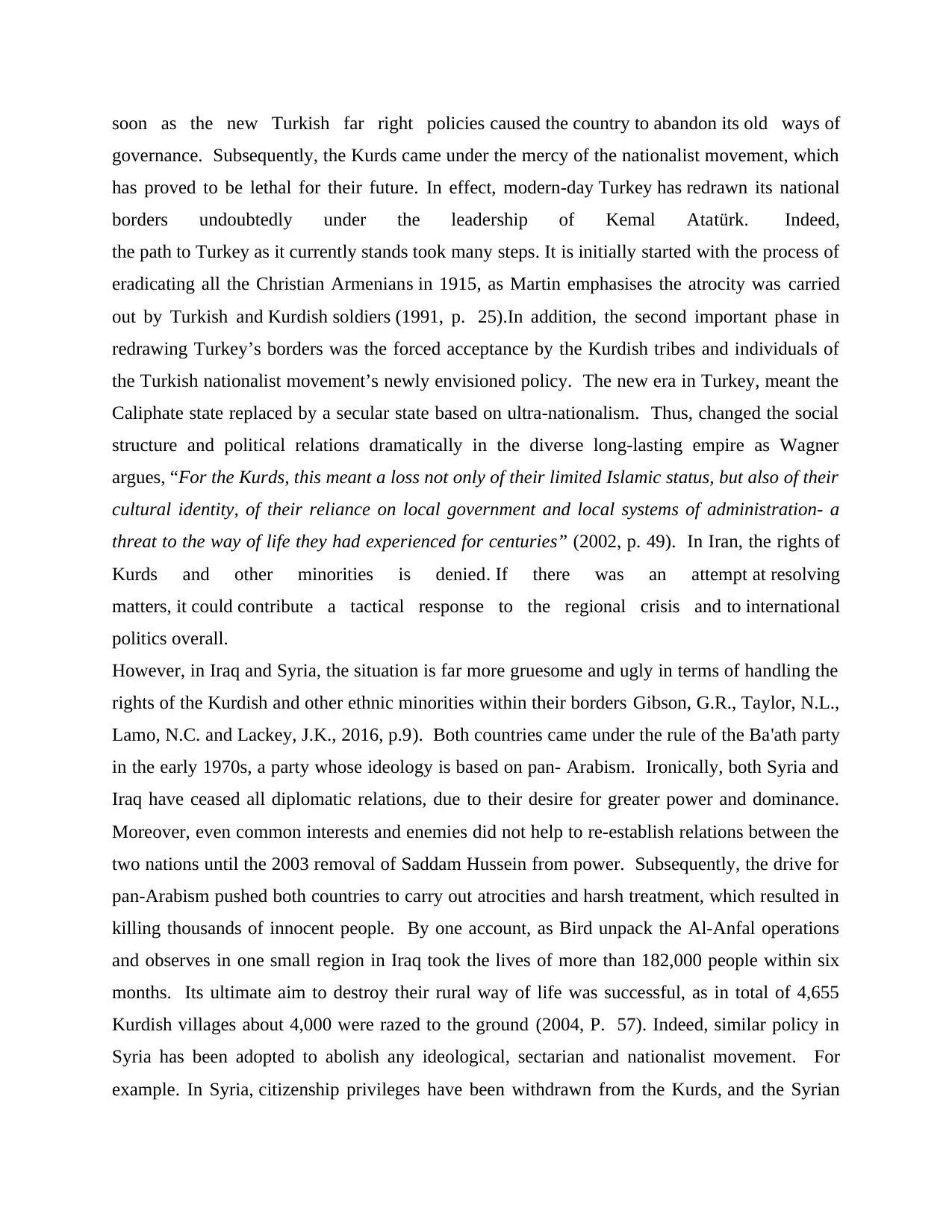
soon as the new Turkish far right policies caused the country to abandon its old ways of
governance. Subsequently, the Kurds came under the mercy of the nationalist movement, which
has proved to be lethal for their future. In effect, modern-day Turkey has redrawn its national
borders undoubtedly under the leadership of Kemal Atatürk. Indeed,
the path to Turkey as it currently stands took many steps. It is initially started with the process of
eradicating all the Christian Armenians in 1915, as Martin emphasises the atrocity was carried
out by Turkish and Kurdish soldiers (1991, p. 25).In addition, the second important phase in
redrawing Turkey’s borders was the forced acceptance by the Kurdish tribes and individuals of
the Turkish nationalist movement’s newly envisioned policy. The new era in Turkey, meant the
Caliphate state replaced by a secular state based on ultra-nationalism. Thus, changed the social
structure and political relations dramatically in the diverse long-lasting empire as Wagner
argues, “For the Kurds, this meant a loss not only of their limited Islamic status, but also of their
cultural identity, of their reliance on local government and local systems of administration- a
threat to the way of life they had experienced for centuries” (2002, p. 49). In Iran, the rights of
Kurds and other minorities is denied. If there was an attempt at resolving
matters, it could contribute a tactical response to the regional crisis and to international
politics overall.
However, in Iraq and Syria, the situation is far more gruesome and ugly in terms of handling the
rights of the Kurdish and other ethnic minorities within their borders Gibson, G.R., Taylor, N.L.,
Lamo, N.C. and Lackey, J.K., 2016, p.9). Both countries came under the rule of the Ba'ath party
in the early 1970s, a party whose ideology is based on pan- Arabism. Ironically, both Syria and
Iraq have ceased all diplomatic relations, due to their desire for greater power and dominance.
Moreover, even common interests and enemies did not help to re-establish relations between the
two nations until the 2003 removal of Saddam Hussein from power. Subsequently, the drive for
pan-Arabism pushed both countries to carry out atrocities and harsh treatment, which resulted in
killing thousands of innocent people. By one account, as Bird unpack the Al-Anfal operations
and observes in one small region in Iraq took the lives of more than 182,000 people within six
months. Its ultimate aim to destroy their rural way of life was successful, as in total of 4,655
Kurdish villages about 4,000 were razed to the ground (2004, P. 57). Indeed, similar policy in
Syria has been adopted to abolish any ideological, sectarian and nationalist movement. For
example. In Syria, citizenship privileges have been withdrawn from the Kurds, and the Syrian
governance. Subsequently, the Kurds came under the mercy of the nationalist movement, which
has proved to be lethal for their future. In effect, modern-day Turkey has redrawn its national
borders undoubtedly under the leadership of Kemal Atatürk. Indeed,
the path to Turkey as it currently stands took many steps. It is initially started with the process of
eradicating all the Christian Armenians in 1915, as Martin emphasises the atrocity was carried
out by Turkish and Kurdish soldiers (1991, p. 25).In addition, the second important phase in
redrawing Turkey’s borders was the forced acceptance by the Kurdish tribes and individuals of
the Turkish nationalist movement’s newly envisioned policy. The new era in Turkey, meant the
Caliphate state replaced by a secular state based on ultra-nationalism. Thus, changed the social
structure and political relations dramatically in the diverse long-lasting empire as Wagner
argues, “For the Kurds, this meant a loss not only of their limited Islamic status, but also of their
cultural identity, of their reliance on local government and local systems of administration- a
threat to the way of life they had experienced for centuries” (2002, p. 49). In Iran, the rights of
Kurds and other minorities is denied. If there was an attempt at resolving
matters, it could contribute a tactical response to the regional crisis and to international
politics overall.
However, in Iraq and Syria, the situation is far more gruesome and ugly in terms of handling the
rights of the Kurdish and other ethnic minorities within their borders Gibson, G.R., Taylor, N.L.,
Lamo, N.C. and Lackey, J.K., 2016, p.9). Both countries came under the rule of the Ba'ath party
in the early 1970s, a party whose ideology is based on pan- Arabism. Ironically, both Syria and
Iraq have ceased all diplomatic relations, due to their desire for greater power and dominance.
Moreover, even common interests and enemies did not help to re-establish relations between the
two nations until the 2003 removal of Saddam Hussein from power. Subsequently, the drive for
pan-Arabism pushed both countries to carry out atrocities and harsh treatment, which resulted in
killing thousands of innocent people. By one account, as Bird unpack the Al-Anfal operations
and observes in one small region in Iraq took the lives of more than 182,000 people within six
months. Its ultimate aim to destroy their rural way of life was successful, as in total of 4,655
Kurdish villages about 4,000 were razed to the ground (2004, P. 57). Indeed, similar policy in
Syria has been adopted to abolish any ideological, sectarian and nationalist movement. For
example. In Syria, citizenship privileges have been withdrawn from the Kurds, and the Syrian
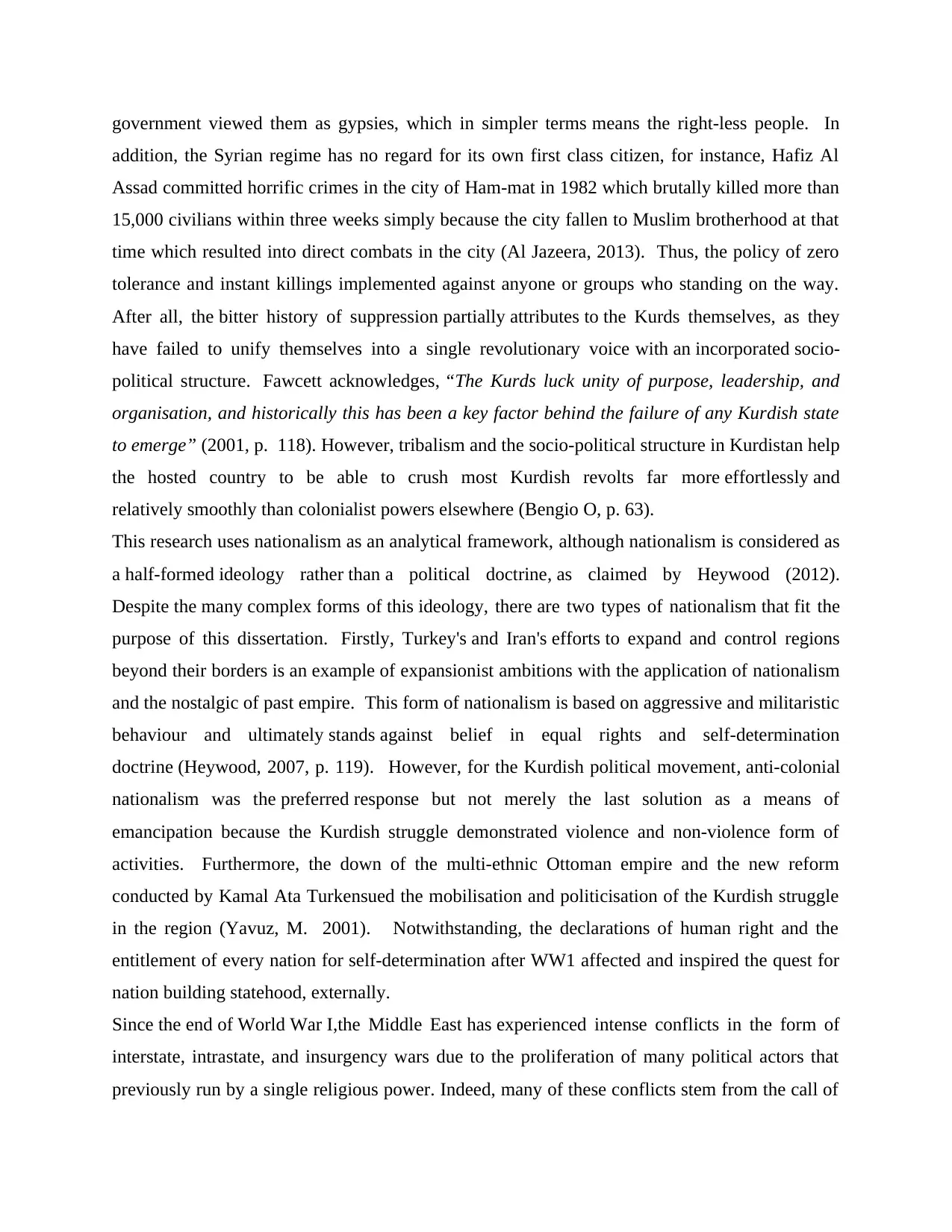
government viewed them as gypsies, which in simpler terms means the right-less people. In
addition, the Syrian regime has no regard for its own first class citizen, for instance, Hafiz Al
Assad committed horrific crimes in the city of Ham-mat in 1982 which brutally killed more than
15,000 civilians within three weeks simply because the city fallen to Muslim brotherhood at that
time which resulted into direct combats in the city (Al Jazeera, 2013). Thus, the policy of zero
tolerance and instant killings implemented against anyone or groups who standing on the way.
After all, the bitter history of suppression partially attributes to the Kurds themselves, as they
have failed to unify themselves into a single revolutionary voice with an incorporated socio-
political structure. Fawcett acknowledges, “The Kurds luck unity of purpose, leadership, and
organisation, and historically this has been a key factor behind the failure of any Kurdish state
to emerge” (2001, p. 118). However, tribalism and the socio-political structure in Kurdistan help
the hosted country to be able to crush most Kurdish revolts far more effortlessly and
relatively smoothly than colonialist powers elsewhere (Bengio O, p. 63).
This research uses nationalism as an analytical framework, although nationalism is considered as
a half-formed ideology rather than a political doctrine, as claimed by Heywood (2012).
Despite the many complex forms of this ideology, there are two types of nationalism that fit the
purpose of this dissertation. Firstly, Turkey's and Iran's efforts to expand and control regions
beyond their borders is an example of expansionist ambitions with the application of nationalism
and the nostalgic of past empire. This form of nationalism is based on aggressive and militaristic
behaviour and ultimately stands against belief in equal rights and self-determination
doctrine (Heywood, 2007, p. 119). However, for the Kurdish political movement, anti-colonial
nationalism was the preferred response but not merely the last solution as a means of
emancipation because the Kurdish struggle demonstrated violence and non-violence form of
activities. Furthermore, the down of the multi-ethnic Ottoman empire and the new reform
conducted by Kamal Ata Turkensued the mobilisation and politicisation of the Kurdish struggle
in the region (Yavuz, M. 2001). Notwithstanding, the declarations of human right and the
entitlement of every nation for self-determination after WW1 affected and inspired the quest for
nation building statehood, externally.
Since the end of World War I,the Middle East has experienced intense conflicts in the form of
interstate, intrastate, and insurgency wars due to the proliferation of many political actors that
previously run by a single religious power. Indeed, many of these conflicts stem from the call of
addition, the Syrian regime has no regard for its own first class citizen, for instance, Hafiz Al
Assad committed horrific crimes in the city of Ham-mat in 1982 which brutally killed more than
15,000 civilians within three weeks simply because the city fallen to Muslim brotherhood at that
time which resulted into direct combats in the city (Al Jazeera, 2013). Thus, the policy of zero
tolerance and instant killings implemented against anyone or groups who standing on the way.
After all, the bitter history of suppression partially attributes to the Kurds themselves, as they
have failed to unify themselves into a single revolutionary voice with an incorporated socio-
political structure. Fawcett acknowledges, “The Kurds luck unity of purpose, leadership, and
organisation, and historically this has been a key factor behind the failure of any Kurdish state
to emerge” (2001, p. 118). However, tribalism and the socio-political structure in Kurdistan help
the hosted country to be able to crush most Kurdish revolts far more effortlessly and
relatively smoothly than colonialist powers elsewhere (Bengio O, p. 63).
This research uses nationalism as an analytical framework, although nationalism is considered as
a half-formed ideology rather than a political doctrine, as claimed by Heywood (2012).
Despite the many complex forms of this ideology, there are two types of nationalism that fit the
purpose of this dissertation. Firstly, Turkey's and Iran's efforts to expand and control regions
beyond their borders is an example of expansionist ambitions with the application of nationalism
and the nostalgic of past empire. This form of nationalism is based on aggressive and militaristic
behaviour and ultimately stands against belief in equal rights and self-determination
doctrine (Heywood, 2007, p. 119). However, for the Kurdish political movement, anti-colonial
nationalism was the preferred response but not merely the last solution as a means of
emancipation because the Kurdish struggle demonstrated violence and non-violence form of
activities. Furthermore, the down of the multi-ethnic Ottoman empire and the new reform
conducted by Kamal Ata Turkensued the mobilisation and politicisation of the Kurdish struggle
in the region (Yavuz, M. 2001). Notwithstanding, the declarations of human right and the
entitlement of every nation for self-determination after WW1 affected and inspired the quest for
nation building statehood, externally.
Since the end of World War I,the Middle East has experienced intense conflicts in the form of
interstate, intrastate, and insurgency wars due to the proliferation of many political actors that
previously run by a single religious power. Indeed, many of these conflicts stem from the call of
⊘ This is a preview!⊘
Do you want full access?
Subscribe today to unlock all pages.

Trusted by 1+ million students worldwide
1 out of 37
Related Documents
Your All-in-One AI-Powered Toolkit for Academic Success.
+13062052269
info@desklib.com
Available 24*7 on WhatsApp / Email
![[object Object]](/_next/static/media/star-bottom.7253800d.svg)
Unlock your academic potential
Copyright © 2020–2025 A2Z Services. All Rights Reserved. Developed and managed by ZUCOL.





